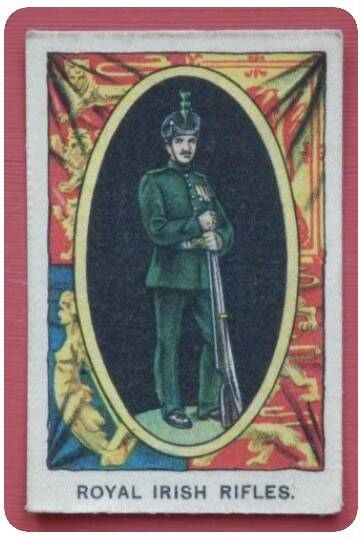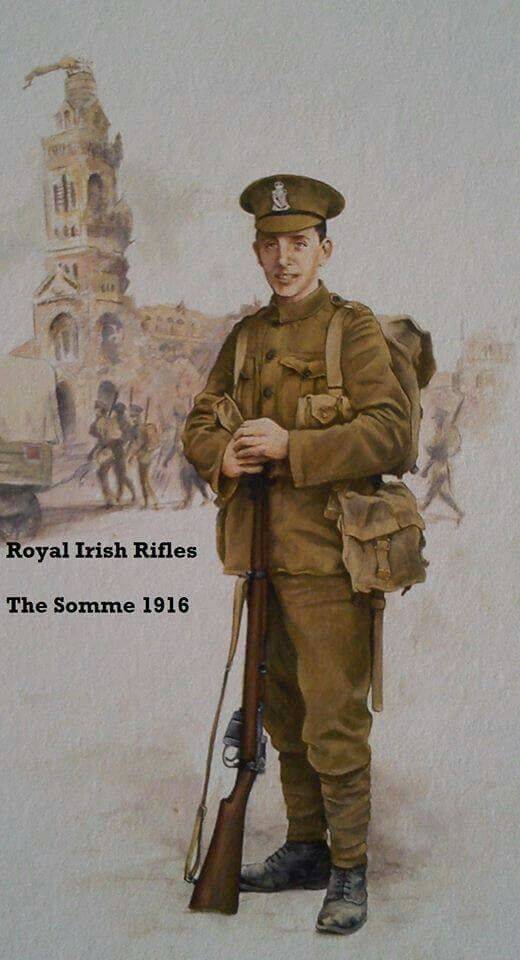Royal Irish Rifles
1881 - 1921
Formation

The Regiment was formed in 1881 as The Royal Irish Rifles by merging two Irish line infantry regiments, the 83rd (County of Dublin) Regiment of Foot and the 86th (Royal County Down) Regiment of Foot. Although neither of these two Regiments had been rifle units, the new Regiment was given that status and role.
The 83rd became the new unit’s 1st Battalion and was already fighting in South Africa at the time. It moved to Guernsey the following year.
In 1881, whilst in Bermuda, the 86th Foot was converted into the new regiment’s 2nd Battalion, before it moved to Nova Scotia in 1883.
In the late 1880s, the 2nd Battalion and a detachment from the 1st Battalion fought in the Sudan, but the 1st Battalion as a whole did not leave the British Isles again until 1897, when it moved back to Natal and from there onto India. The 2nd Battalion fought throughout the Boer War (1899-1902), returning to Ireland in 1903 and then went to Tidworth, England three years later.

World War 1
On the outbreak of the Great War, the 2nd Battalion was deployed straight to the Western Front. The 1st Battalion joined it there from Aden in November 1914 and both remained there until the Armistice.
In addition to their two regular battalions, the Royal Irish Rifles raised a number of Service, and home based Reserve and Garrison battalions, in total, 22 battalions: 2 Regular; 11 Service; 8 Reserve; and 1 Garrison.
Details for each battalion directly below.
***
During the war, the Victoria Cross was awarded to three men from the Royal Irish Rifles:
Edward De Wind, 15th Bttn - 21st March 1918 at Grugies, France.
William McFadzean, 14th Bttn - 1st July 1916 at Theipval, France.
Robert Quigg, 12th Bttn - 1st July 1916 at Hamel, France.
At least 7,340 men from the Royal Irish Rifles died during and shortly after the end first world war. All their names are listed below:
***
The War Diaries of the 1st & 2nd Battalion, RIR during World War 1
There is a wealth of information on all the Irish regiments on the website of the COMBINED IRISH REGIMENTS' OLD COMRADES ASSOCIATION.
It is well worth a visit!

Royal Irish Rifles - Long, Long Trail WW1 website
1st Battalion
August 1914 : in Aden. Returned to UK and landed at Liverpool on 22 October 1914.
Moved to Hursley Park and came under command of 25th Brigade in 8th Division.
6 November 1914 : landed at Le Havre.
3 February 1918 : transferred to 107th Brigade in 36th (Ulster) Division.
2nd Battalion
August 1914 : at Tidworth. Part of 7th Brigade in 3rd Division.
14 August 1914 : landed at Rouen.
8 October 1915 : transferred with Brigade to 25th Division.
26 October 1915 : transferred to 74th Brigade in same Division.
13 November 1917 : transferred to 108th Brigade in 36th (Ulster) Division, absorbing 7th Battalion.
8 February 1918 : transferred to 107th Brigade in same Division.
3rd (Reserve) Battalion
August 1914 : at Belfast. A training unit of the Special Reserve, it moved on mobilisation to Dublin. Returned to Belfast in April 1916. Moved to England in April 1918, going to Larkhill. Absorbed the 17th, 18th, 19th and 20th (Reserve) Battalions in May.
4th (Extra Reserve) Battalion
August 1914 : at Newtownards. A training unit of the Special Reserve, it moved on mobilisation to Holywood Barracks, with detachments going on coast defences. Moved to Carrickfergus in April 1915 and on to Newry in April 1917. Moved to England in April 1918, going to Larkhill.
5th (Extra Reserve) Battalion
August 1914 : at Downpatrick. A training unit of the Special Reserve, it moved on mobilisation to Belfast. Moved to Holywood in May 1915 and on to Ballykinlar in March 1918. Moved to England in April 1918, going to Larkhill.
6th (Service) Battalion
Formed at Dublin in August 1914 as part of K1 and came under command of 29th Brigade in 10th (Irish) Division. Moved to the Curragh in February 1915.
May 1915 : moved to Hackwood Park (Basingstoke).
7 July 1915: embarked at Liverpool and sailed to Gallipoli via Mudros. Landed Anzac Cove 5 August 1915.
29 September 1915 : moved via Mudros to Salonika, arriving 4-5 October.
September 1917 : moved to Egypt for service in Palestine.
15 May 1918 : disbanded at Deir-el-Nidham.
7th (Service) Battalion
Formed at Belfast in September 1914 as part of K2 and came under command of 48th Brigade in 16th (Irish) Division. Moved in January 1915 to Ballyvonare.
5 March 1915 : absorbed a company of the Royal Jersey Militia. Moved in June 1915 to Ballyholley and to England in September, going to Aldershot.
20 December 1915 : landed at le Havre.
23 August 1917 : transferred to 49th Brigade in same Division.
14 October 1917 : transferred to 108th Brigade in 36th (Ulster) Division. Absorbed into 2nd Bn on 14 November 1917.
8th (Service) Battalion (East Belfast)
Formed in Belfast in September 1914 from the Belfast Volunteers. Moved to Ballykinlare and came under orders of 107th Brigade in 36th (Ulster) Division.
July 1915 : moved to Seaford.
October 1915 : landed at Boulogne.
29 August 1917 : amalgamated with 9th Bn to form 8/9th Bn.
7 February 1918 : disbanded in France.
9th (Service) Battalion (West Belfast)
Formed in Belfast in September 1914 from the Belfast Volunteers. Record same as 8th Bn.
10th (Service) Battalion (South Belfast)
Formed in Belfast in September 1914 from the Belfast Volunteers. Moved at first to Newcastle and disbanded on 20 February 1918 but otherwise record same as 8th Bn.
11th (Service) Battalion (South Antrim)
Formed in County Antrim in September 1914 from the Antrim Volunteers. Came under orders of 108th Brigade in 36th (Ulster) Division. Moved to Clandeboye in December 1914.
July 1915 : moved to Seaford.
October 1915 : landed at Boulogne.
13 November 1917 : amalgamated with 13th Bn to form 11/13th Bn.
18 February 1918 : disbanded in France, troops going to 22nd Entrenching Battalion.
12th (Service) Battalion (Central Antrim)
Formed in County Antrim in September 1914 from the Antrim Volunteers. Moved to Newtownards and came under orders of 108th Brigade in 36th (Ulster) Division.
July 1915 : moved to Seaford.
October 1915 : landed at Boulogne.
13th (Service) Battalion (1st County Down)
Formed in County Down in September 1914 from the Down Volunteers. Moved to Clandeboye and came under orders of 108th Brigade in 36th (Ulster) Division. Record same as 11th Bn.
14th (Service) Battalion (Young Citizens)
Formed in Belfast in September 1914 from the Belfast Volunteers. Came under orders of 109th Brigade in 36th (Ulster) Division. Moved to Bundoran in December 1914, going on to Randalstown in January 1915.
July 1915 : moved to Seaford.
October 1915 : landed at Boulogne.
18 February 1918 : disbanded in France.
15th (Service) Battalion (North Belfast)
Formed in Belfast in September 1914 from the Belfast Volunteers. Moved to Ballykinlar and came under orders of 107th Brigade in 36th (Ulster) Division.
July 1915 : moved to Seaford.
October 1915 : landed at Boulogne.
16th (Service) Battalion (2nd County Down) (Pioneers)
Formed at Lurgan in September 1914 from the Down Volunteers. became Pioneer Battalion to 36th (Ulster) Division in January 1915.
July 1915 : moved to Seaford.
October 1915 : landed at Le Havre.
17th (Reserve) Battalion
Formed in Newcastle in March 1915 as a Reserve Battalion, from depot companies of 8th, 9th and 10th Bns. Moved to Ballykinlar in October 1915 and went on to Dundalk in August 1917. Moved to England in April 1918, going to Larkhill where absorbed by 3rd (Reserve) Bn.
18th (Reserve) Battalion
Formed in Holywood in April 1915 as a Reserve Battalion, from depot companies of 11th and 12th Bns. Moved to Clandeboye in July 1915. Moved to England in April 1918, going to Larkhill where absorbed by 3rd (Reserve) Bn.
19th (Reserve) Battalion
Formed in Newcastle around October 1915 as a Reserve Battalion, from depot companies of 14th and 15th Bns. Moved to England in April 1918, going to Larkhill where absorbed by 3rd (Reserve) Bn.
20th (Reserve) Battalion
Formed in Holywood around November 1915 as a Reserve Battalion, from depot companies of 13th and 16th Bns. Moved to Dublin but was at Newtownards by February 1916. Moved to England in April 1918, going to Larkhill where absorbed by 3rd (Reserve) Bn.
Other Battalions
1st Garrison Battalion
Formed in Dublin in November 1915 and moved to India in February 1916. Some evidence that it was at Dundalk shortly before departure. Appears to have been at Cawnpore, Allahabad and possibly Shahjahanpur.
After World War 1
In 1919 the 2nd Battalion was sent to Iraq, moving on to Egypt and Turkey before settling in India for nine years in 1923.
The early 1920s led to two changes for the Regiment:
- the ‘Irish’ in its name was changed to ‘Ulster’
- it lost one of its recruiting counties, Louth, which had become part of the Irish Free State.
Its other two counties, Antrim and Down, were in Northern Ireland and so the Regiment survived to exist beyond Irish independence.
The Royal Irish Rifles became the Royal Ulster Rifles on 1 January 1921.
In 1937, the regiment moved from Victoria Barracks, Belfast to St Patrick's Barracks, Ballymena. In the same year the close relationship with the London Irish Rifles was formally recognised when they were incorporated into the Corps. The Ulster Rifles saw service in the Second World War, and the Korean War.
In 1968 the Royal Ulster Rifles was amalgamated with the other regiments of the North Irish Brigade, the Royal Irish Fusiliers (Princess Victoria's), and the Royal Inniskilling Fusiliers to create the Royal Irish Rangers. In 1992 The Royal Irish Rangers joined with the Ulster Defence Regiment to create the Royal Irish Regiment.
Video: The Royal Irish- 2023






Create Your Own Website With Webador